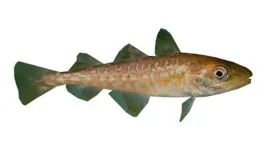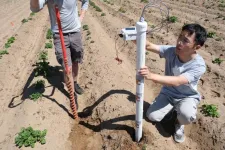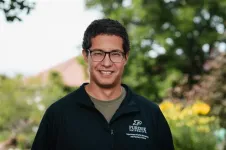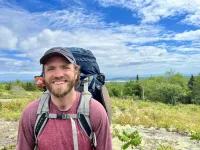(Press-News.org) For a broad range of industries, separating gases is an important part of both process and product—from separating nitrogen and oxygen from air for medical purposes to separating carbon dioxide from other gases in the process of carbon capture or removing impurities from natural gas.
Separating gases, however, can be both energy-intensive and expensive. “For example, when separating oxygen and nitrogen, you need to cool the air to very low temperatures until they liquefy. Then, by slowly increasing the temperature, the gases will evaporate at different points, allowing one to become a gas again and separate out,” explains Wei Zhang, a University of Colorado Boulder professor of chemistry and chair of the Department of Chemistry. “It’s very energy intensive and costly.”
Much gas separation relies on porous materials through which gases pass and are separated. This, too, has long presented a problem, because these porous materials generally are specific to the types of gases being separated. Try sending any other types of gas through them and they don’t work.
However, in research published today in the journal Science, Zhang and his co-researchers detail a new type of porous material that can accommodate and separate many different gases and is made from common, readily available materials. Further, it combines rigidity and flexibility in a way that allows size-based gas separation to happen at a greatly decreased energy cost.
“We are trying to make technology better,” Zhang says, “and improve it in a way that’s scalable and sustainable.”
Adding flexibility
For a long time, the porous materials used in gas separation have been rigid and affinity-based—specific to the types of gases being separated. The rigidity allows the pores to be well-defined and helps direct the gases in separating, but also limits the number of gases that can pass through because of varying molecule sizes.
For several years, Zhang and his research group worked to develop a porous material that introduces an element of flexibility to a linking node in otherwise rigid porous material. That flexibility allows the molecular linkers to oscillate, or move back and forth at a regular speed, changing the accessible pore size in the material and allowing it to be adapted to multiple gases.
“We found that at room temperature, the pore is relatively the largest and the flexible linker barely moves, so most gases can get in,” Zhang says. “When we increase the temperature from room temperature to about 50 degrees (Celsius), oscillation of the linker becomes larger, causing effective pore size to shrink, so larger gases can’t get in. If we keep increasing the temperature, more gases are turned away due to increased oscillation and further reduced pore size. Finally, at 100 degrees, only the smallest gas, hydrogen, can pass through.”
The material that Zhang and his colleagues developed is made of small organic molecules and is most analogous to zeolite, a family of porous, crystalline materials mostly comprised of silicon, aluminum and oxygen. “It’s a porous material that has a lot of highly ordered pores,” he says. “You can picture it like a honeycomb. The bulk of it is solid organic material with these regular-sized pores that line up and form channels.”
The researchers used a fairly new type of dynamic covalent chemistry that focuses on the boron-oxygen bond. Using a boron atom with four oxygen atoms around it, they took advantage of the reversibility of the bond between the boron and oxygen, which can break and reform again and again, thus enabling self-correcting, error-proof behavior and leading to the formation of structurally ordered frameworks.
“We wanted to build something with tunability, with responsiveness, with adaptability, and we thought the boron-oxygen bond could be a good component to integrate into the framework we were developing, because of its reversibility and flexibility,” Zhang says.
Sustainable solutions
Developing this new porous material did take time, Zhang says: “Making the material is easy and simple. The difficulty was at the very beginning, when we first obtained the material and needed to understand or elucidate its structure—how the bonds form, how angles form within this material, is it two-dimensional or three-dimensional. We had some challenges because the data looked promising, we just didn’t know how to explain it. It showed certain peaks (x-ray diffraction), but we could not immediately figure out what kind of structure those peaks corresponded to."
So, he and his research colleagues took a step back, which can be an important but little-discussed part of the scientific process. They focused on the small-molecule model system containing the same reactive sites as those in their material to understand how molecular building blocks packed in a solid state, and that helped explain the data.
Zhang adds that he and his co-researchers considered scalability in developing this material, since its potential industrial uses would require large amounts, “and we believe this method is highly scalable. The building blocks are commercially available and not expensive, so it could be adopted by industry when the time is right.”
They have applied for a patent on the material and are continuing the research with other building block materials to learn the substrate scope of this approach. Zhang also says he sees potential to partner with engineering researchers to integrate the material into membrane-based applications.
“Membrane separations generally require much less energy, so in the long term they could be more sustainable solutions,” Zhang says. “Our goal is to improve technology to meet industry needs in sustainable ways.”
END
Researchers find flexible solution for separating gases
2024-06-27
ELSE PRESS RELEASES FROM THIS DATE:
Pacific cod can’t rely on coastal safe havens for protection during marine heat waves, OSU study finds
2024-06-27
During recent periods of unusually warm water in the Gulf of Alaska, young Pacific cod in near shore safe havens where they typically spend their adolescence did not experience the protective effects those areas typically provide, a new Oregon State University study found.
Instead, during marine heat waves in 2014-16 and 2019, young cod in these near shore “nurseries” around Kodiak Island in Alaska experienced significant changes in their abundance, growth rates and diet, with researchers estimating that only the largest 15-25% of the island’s cod population survived the summer. Even after the high temperatures subsided, the ...
Bird flu stays stable on milking equipment for at least one hour
2024-06-27
Bird flu, or H5N1 virus, in unpasteurized milk is stable on metal and rubber components of commercial milking equipment for at least one hour, increasing its potential to infect people and other animals, report researchers from the University of Pittsburgh School of Medicine and Emory University in Emerging Infectious Diseases.
The study underscores the heightened risk of bird flu exposure for dairy farm workers and signals the need for wider adoption of personal protective equipment, including face shields, masks and eye protection.
“Dairy cows have to be milked even if they are sick, and it has not been clear for how long the virus contained in residual milk from the ...
Printed sensors in soil could help farmers improve crop yields and save money
2024-06-27
MADISON — University of Wisconsin–Madison engineers have developed low-cost sensors that allow for real-time, continuous monitoring of nitrate in soil types that are common in Wisconsin. These printed electrochemical sensors could enable farmers to make better informed nutrient management decisions and reap economic benefits.
“Our sensors could give farmers a greater understanding of the nutrient profile of their soil and how much nitrate is available for the plants, helping them to make more precise decisions on how much fertilizer they really need,” says Joseph Andrews, an assistant professor of mechanical ...
Neighborhood opportunities influence infant development and cognition
2024-06-27
Growing up in neighborhoods with more educational and socioeconomic opportunities has a positive impact on infants’ brain activity, according to new research from Boston Medical Center (BMC). The study, published in The Journal of Developmental & Behavioral Pediatrics, suggests that enhancing neighborhood opportunities, particularly in education, can be a promising approach to promoting early childhood development.
A team of early childhood researchers examined how neighborhood opportunity – the socioeconomic, educational, health, and ...
New twists on tornadoes: Earth scientist studies why U.S. has so many tornadoes
2024-06-27
WEST LAFAYETTE, Ind. — Across the Midwest during the warmer months, studying the sky for signs of storms and tornadoes becomes one of the most popular pastimes.
Dan Chavas, an associate professor in the Department of Earth, Atmospheric, and Planetary Sciences at Purdue University’s College of Science, takes it further: All day every day, he studies what makes tornadoes tick. Working at the intersection of climate science and meteorology, he looks at the big picture of what causes severe storms and tornadoes — and what dictates where ...
Children’s Hospital of Philadelphia researchers find elementary age children experience more concussions during activities unrelated to sports
2024-06-27
Philadelphia, June 27, 2024 – Researchers from Children’s Hospital of Philadelphia (CHOP) found that young children between the ages of 5 and 12 were more likely to experience a concussion from recreation and other non-sport activities, yet those injuries were not seen by specialists until days later compared with sports-related concussions in the same age group.
This study suggests concussion research is needed for children outside of sports and that providing more resources and education ...
Ultrasounds may not find this cancer in Black women
2024-06-27
A common algorithm to check for endometrial cancer is not reliable for Black women, according to a new study published today in JAMA Oncology.
In Black patients with concerning symptoms, a tissue biopsy is strongly recommended to rule out endometrial cancer instead of using transvaginal ultrasound, the report concluded.
Endometrial cancer is the most common type of gynecological cancer in the United States. It is one of the few types of cancer now on the rise, especially among Black women, who are more likely to be diagnosed at later stages of the disease. This cancer can cause symptoms such as abnormal vaginal ...
Urban green and blue spaces are linked to less coronary artery calcification
2024-06-27
· Black participants with greater access to green spaces had up to 35% lower odds of calcification
· Black participants living near a river had 32% lower odds of calcification
· Coronary artery calcification is an early sign of cardiovascular disease
CHICAGO --- Being near and having more exposure to urban green space and blue (water) space is linked to lower odds of having coronary artery calcification in middle age, which is an early marker of cardiovascular disease.
The associations were more pronounced among Black individuals and those living in neighborhoods ...
US efforts to collect LGBTQ+ data among Medicaid patients is a ‘foundational step towards health equity'
2024-06-27
Compared to straight and cisgender individuals, sexual and gender minority adults in the US are more likely to face barriers paying for or accessing adequate health insurance and healthcare, but few states collect sexual and gender identity (SOGI) information to better understand the health challenges and needs of this population. To close this knowledge gap, the Centers for Medicare & Medicaid Services (CMS) added three optional SOGI questions to its model application, with guidance for states that choose to incorporate the questions into their Medicaid and Child Health Insurance ...
Wolves reintroduced to Isle Royale temporarily affect other carnivores, humans have influence as well
2024-06-27
MADISON–In a rare opportunity to study carnivores before and after wolves were reintroduced to their ranges, researchers from the University of Wisconsin–Madison found that the effects of wolves on Isle Royale have been only temporary. And even in the least-visited national park, humans had a more significant impact on carnivores’ lives.
The paper, published recently in Frontiers in Ecology and the Environment, uses DNA from foxes and martens’ scat and hair to understand where these animals were and what they ...



